CBSE Previous Year Question Papers Class 12 Economics 2016 Delhi
Time allowed : 3 hours
Maximum marks: 70
** Answer is not given due to change in the present syllabus
CBSE Previous Year Question Papers Class 12 Economics 2016 Delhi Set – I
Section – A
Question 1.
What is the relation between marginal cost and average variable cost when marginal cost is rising and average variable cost is falling? [1]
Answer:
Marginal cost lies below the average variable cost when marginal cost is rising and average variable cost is falling. In other words as long as marginal cost is below the average variable cost, the AVC continues to fall, no matter the MC is rising.
Question 2.
Suppose total revenue is rising at a constant rate as more and more units of a commodity are sold, marginal revenue would be : (choose the correct alternative). [1]
(a) Greater than average revenue
(b) Equal to average revenue
(c) Less than average revenue
(d) Rising
Answer:
(b) Equal to Average Revenue.
Question 3.
When does ‘increase’ in demand take place? [1]
Answer:
Increase in demand: Rise in demand takes place due to change in factors other than price of the commodity.
Question 4.
‘Homogenous products’ is a characteristic of : (choose the correct alternative) [1]
(a) Perfect competition only
(b) Perfect oligopoly only
(c) Both (a) and (b)
(d) None of the above
Answer:
(c) (a) and (b)
Question 5.
There is inverse relation between price and demand for the product of a firm under : (choose the correct alternative) [1]
(a) Monopoly only
(b) Monopolistic competition only
(c) Both under monopoly and monopolistic competition
(d) Perfect competition only
Answer:
(c) Both (a) and (b)
Question 6.
A consumer consumes only two goods X and Y. Marginal utilities of X and Y are 5 and 4 respectively. The prices of X and Y are ₹ 4 per unit and ₹ 5 per unit respectively. Is the consumer in equilibrium? What will be the further reaction of the consumer? Explain. [3]
Answer:
Marginal utility of X = 5
Price of X = ₹ 4
Marginal utility of Y = 4
Price of Y = ₹ 5
MUx ÷ Px = 5 ÷ 4 = 1.25
MUy ÷ Py = 4 ÷ 5 = 0.8
No, the consumer is not in an equilibrium because the marginal utility of X is more than the marginal utility of Y and to reach the equilibrium level, the consumer should increase the consumption of good X and decrease the consumption of good Y.
Question 7.
Price elasticity of demand of good X is -2 and of good Y is -3. Which of the two goods is more price elastic and why? [3]
Answer:
Price elasticity of good X = -2
Price elasticity of good Y = -3
Good Y is more price elastic as compared to good X. There is inverse relationship between price and demand. For elasticity, negative sign is ignored and hence.
= 3 > 2
Thus, price elasticity of good Y is more .
Question 8.
What is maximum price ceiling? Explain its implications. [3]
OR
Explain the chain effects, if the prevailing market price is below the equilibrium price.
Answer:
A price ceiling occurs when the government puts a legal limit on how high the price of the product can be. In order for the price ceiling to be effective, it must be set below the natural market equilibrium. It is also known as maximum price. This maximum price is fixed below the equilibrium price for the welfare of poor and vulnerable sections of the society. Implications of price ceiling :
(a) When prices are lowered below the equilibrium price, than the demand increases more as compared to available supply. This leads to the situation of excess demand.
(b) With price ceiling, all the necessity products come under the reach of poorer and vulnerable sections of the society.
(c) Due to price ceiling, there is the situation of more demand and less of supply, since there is less supply, goods are made available to people in a fixed quantity (quota), otherwise this at times lead to a problem of shortage.
OR
When the prevailing market price is below the equilibrium price, then there is a condition of excess demand . This excess demand increases the competition among the buyers and buyers tend to buy the output at higher prices which increases the market price. As the market price starts rising, demand contracts and supply expands. This market price tend to rise till the equilibrium is restored.
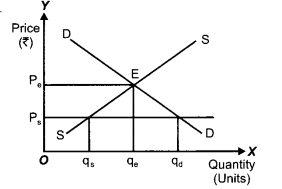
In the above fig, it is assumed that the market price p
s
is below the equilibrium price p
e
. According to demand curve, quantity demanded. q
d
, quantity supplied q
s
, there emerges the situation of excess demand (q
d
– q
s
).
The excess demand pushes the price up from the OP
s
price level. With rise in price, the quantity demanded contracts and quantity supplied expands. This process continues till the equilibrium gets established at point E at OP
e
price level and OQ
e
quantity.
Question 9.
Explain in effect of change in prices of the related goods on demand for the given good. [4]
Answer:
Goods are said to be related when price of one good (say ‘X’) causes change in demand for other good (say ‘Y’). Related goods are of two types:
(a) Substitute goods (direct relationship) : Substitute goods are a pair of goods which can be used (substituted) in place of each other. They are competitive good. Like pepsi and coca-cola or tea and coffee. Demand for a given commodity is affected if the price of its substitute rises or falls. For the case of tea and coffee-the, demand for tea will fall when the price of its substitute-coffee falls. A fall in the price of substitute good (tea) reduces the consumers demand for given good (coffee).
If related good is a substitute of a given good, then a rise in price of substitute good will lead to rise in demand for given good because it becomes relatively cheaper.
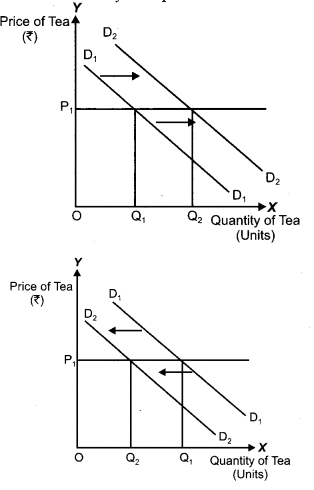
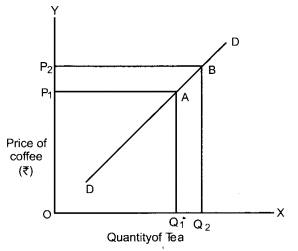
As can be seen is the above graph that when the price of coffee is OP
1
, the demand for tea is OQ
1
. When the price of coffee rises to OP
2
, the demand for tea increased to OQ
2
. Hence there is direct relationship between price of coffee and demand for tea.
(b) Complementary goods (inverse relation¬ship) : Complementary goods are pair of goods which are used together to satisfy a given want. They are complementary to each other in the sense that they complete the deficiencies of each other. For eg fountain pen and ink. A fall in the price of one commodity leads to rise in the de¬mand for the other commodity also. If the price of ink falls, demand for its complementary good -fountain pen will rise. Thus, a fall in price of one complementary good increases the demand for the other complementary good.
If related good is complementary to the given good, then a rise in price of complementary good will result in fall in demand of given good.
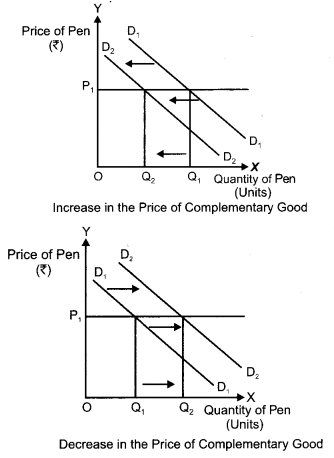
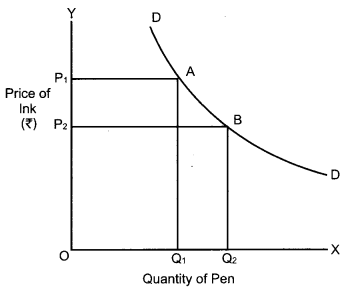
As can be seen is the above graph that when price of the ink was OP
1
, the demand for pen was OQ
1
. When the price of ink falls to OP
2
, the demand for pen rises to OQ
2
. Hence there is an inverse relationship between price of ink and demand for pen.
Question 10.
Define production function. Distinguish between short run and long run production functions. [4]
OR
Define cost. Distinguish between fixed and variable costs. Give one example of each.
Answer:
Production function : Production has been defined as “transformation of inputs into output”. The physical relationship between inputs and outputs under given technology is called production function.
Q = f(F
1
,F
2
………. F
n
)
| Short – Run Production Function | Long-Run Production Function |
| Short-run production function is when one factor is varied while all other factors are kept fixed (constant). | Long-run production function is when all factors are varied (changed) in same proportion. |
| The law which operates here is known as “law of returns to a factor”. | The law which operates in such a situation is known as “law of returns to scale”. |
| It leads to changes in level of production. | It leads to the changes in scale of production. |
OR
Cost: The sum of explicit cost (cash payments made by firms to outsiders for hiring factor services and buying raw materials) and implicit costs (cost of self owned and self supplied inputs) constitute total cost of production of a commodity.
| Fixed Cost | Variable Cost |
| Fixed cost does not increase or decrease with increase or decrease in the level of production. | Variable cost rises or falls with the increase or decrease in the level of production. |
| In short period , fixed cost cannot be changed . | In short period variable cost can be changed. |
| Fixed cost curve is parallel to X-axis . | Variable cost curve is upward sloping. |
| Fixed cost can never be zero even if the production is stopped. | Variable cost is zero when production is stopped. |
| Eg- Rent of a building. | Cost of raw material. |
Question 11.
A producer supplies 80 units of a good at a price of ₹ 10 per unit. Price elasticity of supply is 4. How much will he supply at ₹ 9 per unit ? [4]
Answer:
Given : Q
1
= 80 units, Q
2
= ? P
1
= ₹ 10/ unit and P
2
= ₹ 9/unit and Es = 4
Let Q
2
be x
ΔQ = (Q
2
– Q
1
)
= (x – 80)
ΔP = (P
2
– P
1
)
= (9 – 10)
= -1
Es = (ΔQ ÷ ΔP) × (P ÷ Q)
4 = (x – 80 ÷ (-1) × (10 ÷ 80)
4 = x – 80 ÷ -8
-32 = x – 80
x = 48 units
Thus, a producer will supply 48 units at ₹ 9 per unit.
Question 12.
Assuming that no resource is equally efficient in production of all goods, name the curve which shows production potential of the economy. Explain, giving reasons, its properties. [6]
Answer:
The curve which shows the production potential of the economy , assuming that no resource is equally efficient in production of all goods is ” Production Possibility Curve (PP Curve)”.
Production possibility curve: It is a curve which depicts all possible combinations of two goods which an economy can produce with available technology and with full and efficient use of its given resources.
|
Production possibilities (combinations) |
Wheat (lakh tonnes) |
Tanks (thousands) |
| A | 0 | 15 |
| B | 1 | 14 |
| C | 2 | 12 |
| D | 3 | 9 |
| E | 4 | 5 |
| F | 5 | 0 |
Properties of PP Curve:
(a) Downward sloping curve from left to right: PP Curve is downward sloping from left to right because in a situation of full employment of resources, production of one good can be increased only after sacrificing some quantity of the other good.
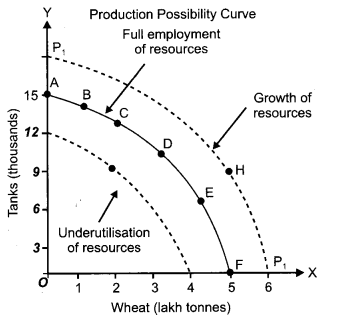
(b) PP curve is concave to the origin: The shape of PP Curve is concave to the origin because of increasing marginal opportunity cost.
(c) Optimum utilisation of resources : When economy is producing on PP Curve, every point on it (A, B, C, D, E ,F) reflects situation of full and efficient employment of resources i.e. optimum utilisation of resources.
Question 13.
Explain the condition of consumer’s equilibrium using indfference curve analysis. [6]
Answer:
According to indifference curve analysis, a consumer attains equilibrium at a point where budget line is tangent to indifference curve. Con¬sumer equilibrium is achieved where slope of indifference curve (MRS) = slope of budget line (Px/Py)
MRS = Px ÷ Py ( Ratio of prices of two goods) Given the indifference map (preference schedule) of the consumer and budget or price line, we can find out the combination which gives the consumer maximum satisfaction. The aim of the consumer is to obtain highest combination on his indifference map and for this he tries to go to the highest indifference curve with his given budget line. He would be in equilibrium only at such point which is common point between budget line and the highest attainable indifference curve. A consumer is in equilibrium at a point where budget line is tangent to indifference curve. At this point, slope of indifference curve (called MRS) is equal to slope of budget line.
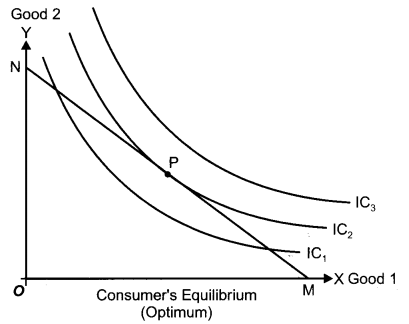
In the above fig, P is the equilibrium point at which budget line M just touches the highest attainable indifference curve IC
2
within consumer budget. Combinations on IC
3
are not affordable because his income does not permit whereas combinations on IC
1
gives lower satisfaction than IC
2
. Hence, best combination is at point P where budget line is tangent to the indifference curve IC
2
. It is at this point that consumer attains the maximum satisfaction at the state of equilibrium.
For consumer’s equilibrium, two conditions are necessary:
(a) Budget line should be tangent to indifference curve (MRS = Px / Py).
(b) Indifference curve should be convex to the point of origin (i.e.. MRS should be diminishing at a point of equilibrium.)
Question 14.
Explain the distinction between “Change in quantity supplied” and “Change in supply”. Use diagram. [6]
Answer:
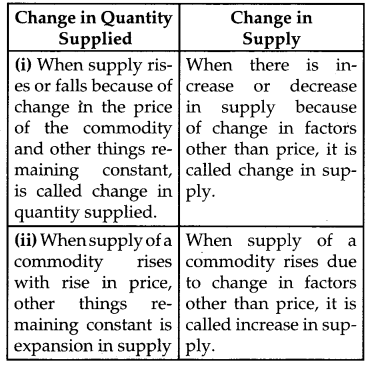
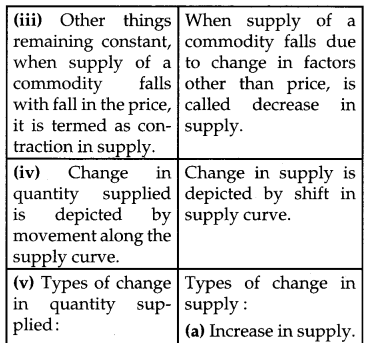
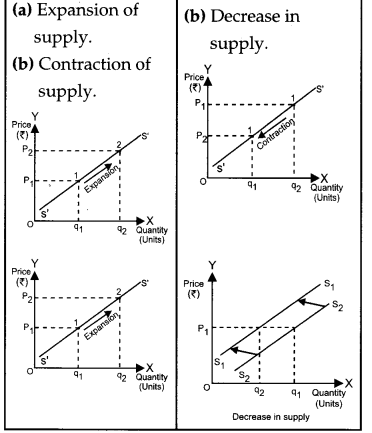
Question 15.
Explain the implication of the following in a perfectly competitive market: [6]
(a) Large number of buyers
(b) Freedom of entry and exit to firms
OR
Explain the implications of the following in an oligopoly market:
(a) Inter-dependence between firms
(b) Non-price competition
Answer:
Implications of the following in perfectly competitive market:
(a) Large number of buyers: There are very large number of buyers in perfectly competitive market that no individual buyer can influence the price or demand of any commodity. An individual buyer is the price taker and not the price maker.
(b) Freedom of entry and exit to the firms: Implies that there are no obstacles for the firms to move in and out of industry. The implication is that when existing firms are making profits, new firms enters, raise the output of industry, brings down the market price enough for the firm to earn only normal profit in the long run. The opposite happens if the existing firms are facing losses.
OR
Implications of the following in oligopoly market:
(a) Inter-dependence between firms: There are very few large firms in oligopoly market and these firms are mutually dependent on each other and hence influence the market price and output. To fix the price and its output , every firm has to consider the decision of the rival firm also as all the firms are mutually dependent on each other.
(b) Non-price competition: Since the firms in oligopolistic market are inter- dependent and they fix the prices together, so there is no price competition among the firms as they fix the price after taking into consideration the decision of all the firms together.
Section – B
Question 16.
Define Stocks. [1]
Answer:
Stock: A stock are the variables whose magnitude is measured at a point of time, e.g. population.
Question 17.
Depreciation of fixed capital assets refers to : (choose the correct alternative) [1]
(a) Normal wear and tear
(b) Foreseen obsolescence
(c) Normal wear and tear and foreseen obsolescence
(d) Unforeseen obsolescence
Answer:
(c) Normal wear and tear and foreseen obsolescence.
Question 18.
What is revenue expenditure? [1]
Answer:
Revenue Expenditure: An expenditure which neither creates assets nor reduces liabilities is called revenue expenditure.
Question 19.
Fiscal deficit equals : (choose the correct alternative) [1]
(a) Interest Payments
(b) Borrowings
(c) Interest payments less borrowing
(d) Borrowings less interest payments
Answer:
(b) Borrowings.
Question 20.
Foreign exchange transactions dependent on other foreign exchange transactions are called: (choose the correct alternative) [1]
(a) Current account transactions
(b) Capital account transactions
(c) Autonomous transactions
(d) Accommodating transaction
Answer:
(d) Accommodating transactions.
Question 21.
Find net value added at factor cost: [3]
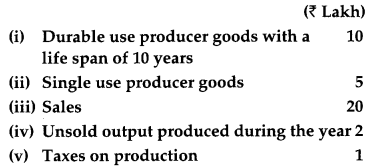
Answer:
Value of output = sales + change in stock
= 20 + 2 = 22 lakh.
Gross value added at market price = value of output – intermediate consumption (single use producer goods)
= 22 – 5 = 17 1akh.
Depreciation = (Cost of producers good ÷ no. of life in years)
= (10 ÷ 10) = 1
Net Indirect taxes = Taxes on production – subsidy
=1 – 0=1
Net value added at FC = GVAmp – Depreciation – Net indirect taxes
= 17 – 1 – 1
= ₹ 15 lakhs.
Question 22.
Distinguish between marginal propensity to consume and average propensity to consume. Give a numerical example. [3]
OR
Explain the role of taxation in reducing excess demand.
Answer:
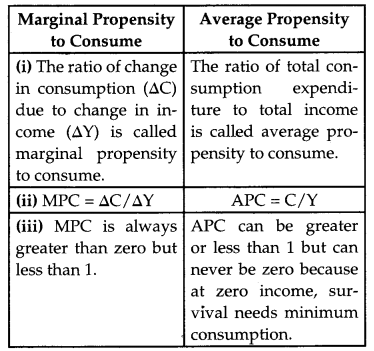
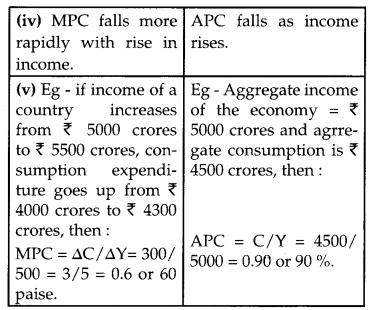
OR
Role of taxation to reduce excess demand :
Important part of fiscal policy is revenue policy which is expressed in terms of taxes. During inflation, government should raise rates of all taxes especially on rich people because taxation withdraws purchasing power from the tax payers and to that extent reduces effective demand. The non-discretionary elements refer to in built stabilizers of income which operate automatically in reducing excess demand like progressive income tax, subsidies, old-age pension and others such as transfer payments .
Question 23.
In an economy investment is increased by ₹ 300 crore. If marginal propensity to consume is 2/3, calculate increase in national income. [3]
Answer:
MPC = 2/3
ΔI = ₹ 300 crores
k = [1 ÷ (1 – MPC)]
= [1 ÷ (1 – 2/3)]
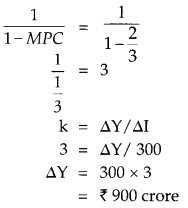
Increase in national income is ₹ 900 crore.
Question 24.
Government incurs expenditure to popularize yoga among the masses. Analyze its impact on gross domestic product and welfare of the people. [4]
Answer:
Impact on GDP: With the help of yoga, people will be in good state of health as well as in a good state of mind and it is rightly said that healthy mind stays in a healthy body. When a person has healthy mind and healthy body, he/ she will work hard towards producing good and increased quantity of goods which will help in increasing the GDP of the economy. People with healthy mind will provide their efficient services to the economy which will have a positive impact on the GDP of the country and will help in increasing the standards of the economy.
Impact on the welfare of people : Yoga keeps the body, mind and soul healthy and happy. With healthy body, mind and soul people are able to work in an efficient manner and help the others in society, rooting up the welfare of all the people in the society.
Question 25.
Explain the “store of value” function of money.
How has it solved the related problem created by barter ?** [4]
OR
Explain the “unit of account’ function of money. How has it solved the related problem created by barter ?**
Question 26.
Explain how open market operations are helpful in controlling credit creation. [4]
Answer:
Open market operations : Open market operations refer to buying and selling of government securities by central bank to public and banks. This is done to influence money supply in the country. Sale of government securities to commercial bank means flow of money into central bank which reduces cash reserves. Consequently, credit availability of commercial banks is controlled.
On the other hand, if R.B.I purchases government securities, it will increase the money supply with commercial banks that will increase their lending capacity and flow of money into the economy,
Question 27.
What is government budget ? Explain how taxes and subsidies can be used to influence allocation of resources. [6]
Answer:
A government budget is an annual financial statement of estimated revenue and estimated expenditure during a financial year. Government budget is a statement of its income and expenditure.
Through budgetary policy, government aims to allocate resources in accordance with economic (profit maximisation) and social (public welfare) priorities of the country.
To encourage investments, government can give tax concessions, subsidies, etc. to the producers. For example : government discourages the production of harmful consumption goods like liquor or cigarettes, etc. through levying heavy taxes and encourages the use and production of “khaadi” products by providing subsidies. Government budget can be used to bring price stability or economic stability in the economy :
Government can bring price/economic stability i.e., control fluctuations in the general price level through taxes, subsidies and expenditure. For instance, when there is inflation (continuous rise in price), government can reduce its own expenditure. When there is depression, government can reduce taxes and grant subsidies to encourage spending by the people.
Question 28.
Given Consumption curve, derive saving curve and state the steps taken in the process of derivation. Use diagram. [6]
Answer:
Consumption + saving is always equal to income because income is either consumed or saved. It implies that consumption and saving curves representing consumption and saving functions are complementary curves.
In part A, CC curve shows consumption function whereas 45° line represents income. C curve intersects 45° line at point B at which BR = OR i.e., consumption = income. Point B is the break even point showing zero saving. It states that saving curve must intersect X-axis at the same income level where consumption curve and 45° line intersects. Left of point B is negative saving and to the right of point B is positive saving.
In part B, we derive saving function in the form of saving curve. In part A , the amount of saving is the vertical distance between C curve and 45°line. By plotting, the vertical distances of saving/dissaving and by joining them, we derive a saving curve. In part A the vertical distance OC (dissaving) is plotted as OS
1
below X-axis in part-B. At OR level of income in Part A, vertical distance at point B is shown as point B
1
on X-axis in lower part of figure is nil. LM of part A is shown as L
1
M
1
in part -B. By joining points S, B
1
and L
1
in lower segment, we get saving curve. Thus saving curve is derived from consumption curve.
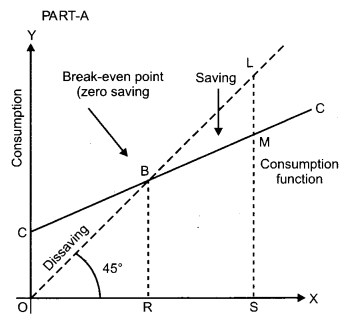
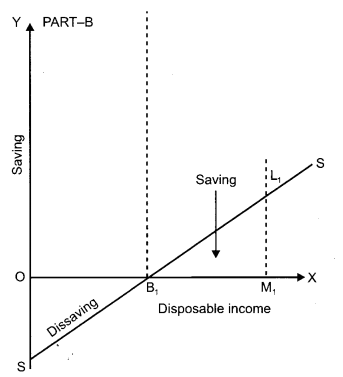
Question 29.
(a) In which sub-account and on which side of balance of payments account will foreign investments in India be recorded ? Give reasons.
(b) What will be the effect of foreign investment in India on exchange rate? Explain. [6]
Answer:
(a) Foreign investments in India will be recorded in the capital account on the credit side of Balance of Payments accounts. It is recorded as the positive item in the capital account of BOP because foreign investments is an inflow of foreign currency into our country and give rise to foreign exchange liabilities.
(b) Foreign investment in India will increase the supply of foreign currency in our country. This increase in supply is reflected as shift in the supply curve. With the shift, new equilibrium point is established, where exchange rate falls and thus the demand and supply of foreign currency rises and exchange rate falls. This will continue till the equilibrium is reached.
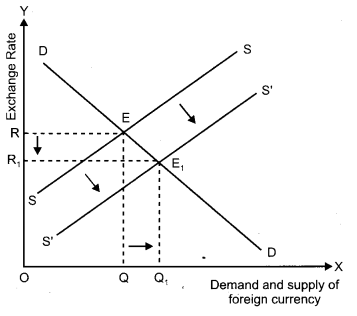
As can be seen in the above diagram that the supply curve of foreign exchange is SS. As the foreign investment in India increases, the supply curve of foreign exchange shifts to rightward and now the new supply curve is S’S’. This shift in supply curve from SS to S’S’ changes the equilibrium from E to E
1
where the exchange rate falls from OR to OR
1
and demand and supply quantity of foreign exchange rises from OQ to OQ
1
. Hence the new equilibrium gets established at OR
1
exchange rate and OQ
1
quantity of foreign exchange.
Question 30.
Find national income and (private income**): [6]
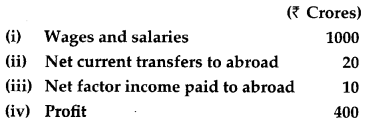

Answer:
NNP
fc
= NNP
fc
= Wages and salaries + Social security contributions by employers + Rent + interest + profit + royalty – Net factor income paid to abroad.
NNP
fc
= 1000 + 100 + 200 + 300 + 400 + 50 – 10
= 2050 – 10
= ₹ 2040 crores
CBSE Previous Year Question Papers Class 12 Economics 2016 Delhi Set – II
Section – A
Note : Except for the following questions, all the remaining questions have been asked in previous set.
Question 4.
When does ‘increase” in supply take place ? [1]
Answer:
When supply of a commodity rises due to change in factors other than the price, it is called increase in supply. Increase in supply is the rightward shift of the supply curve.
Question 5.
What is the relation between marginal cost and average cost when average cost is constant? [1]
Answer:
Relation between marginal cost and average cost when average cost is constant is, marginal cost is also constant because at this point MC curve cuts the AC curve which implies that MC = AC, and AC curve is at its minimum point.
Question 7.
A consumer consumes only two goods X and Y. If marginal utilities of X and Y are 4 and 5 respectively, and if price of X is ₹ 5 per unit and that of Y is ₹ 4 per unit, is the consumer in equilibrium? What will be further reaction of the consumer? Explain. [3]
Answer:
Marginal utility of X = 4
Price of X = ₹ 5
Marginal utility of Y = 5
Price of Y = ₹ 4
MUx ÷ Px = 4 ÷ 5 = 0.8
MUy ÷ Py = 5 ÷ 4 = 1.25
The ratio of MUy to the price of Y is greater than the ratio of MUx to the price of X, so the consumer is not at equilibrium and to reach equilibrium level, consumer should increase the consumption of good Y and decrease the consumption of good X.
Question 9.
Price elasticity of supply of a good is 2. A producer supplies 100 units of a good at a price of ₹ 20 per unit. At what price will he supply 80 units. [4]
Answer:
Elasticity of supply (Es) = 2
Quantity supplied (Q) = 100 units
Price (P) = ₹ 20/unit
New quantity (Q
1
) = 80 units
New price (P
1
) = ?
Change in quantity supplied
(ΔQ) = Q
1
– Q
= 80 – 100
= -20 units.
Es = (ΔQ ÷ AP) × (P ÷ Q)
2 = (-20 ÷ ΔP) × (20 ÷ 100) 2
= (-20/(-ΔP) × (1/5)
(-ΔP is taken because prices are fallen, supply is falling)
2 = (-4/ (-ΔP))
2ΔP = -4
-ΔP = -4/2
-ΔP = -2
ΔP = 2
ΔP = (P – Pl)
2 = (20 – PI)
PI = 20 – 2 = ₹ 18
Hence, the seller will supply 80 units at ₹ 18 per unit.
Question 10.
Explain the effects of change in income on demand for a good. [4]
Answer:
Effects of change in income on demand for a good: Relationship between income and demand is direct in case of normal good but negative in case of inferior good.
(a) In case of normal good, an increase in income of the buyer will increase the demand at the same price because he can afford to buy more and shift the demand curve to the right but fall in the income will decrease the demand and shift the demand curve to the left.
(b) In case of an inferior good , an increase in income usually leads to decrease in demand at the same price and shift the demand curve to the left but decrease in income leads to increase in demand at the same price and shifts the demand curve to the right.
CBSE Previous Year Question Papers Class 12 Economics 2016 Delhi Set – III
Section – A
Question 3.
What is the relation between Marginal Cost and Average Cost when average cost is rising? [1]
Answer:
When AC is rising, MC rises at a faster rate and MC remains above AC curve.
Question 5.
When does ‘Decrease’ in supply take place? [1]
Answer:
Decrease in supply refers to the fall in the supply due to unfavourable changes in the determinants other than price of a good. Graphically, decrease in supply is indicated by a leftward upward shift of the supply curve.
Question 8.
A consumer consumes only two goods X and Y. Marginal utility of each is 2. The price per unit of X and Y is ₹ 1 and ₹ 2 respectively. Is the consumer in equilibrium? What will be the further reaction of the consumer? Explain. [1]
Answer:
According to the utility approach, a consumer reaches equilibrium where the following equality is met.
\(\frac{\mathrm{MUx}}{\mathrm{P}_{\mathrm{x}}}=\frac{\mathrm{MU} \mathrm{y}}{\mathrm{P}_{\mathrm{y}}}\)
According to the given question :
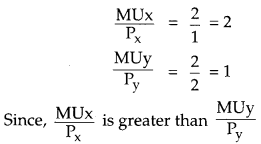
Thus, a consumer is not in equilibrium. In order to reach the equilibrium, a rational consumer would increase the consumption of good X and decrease that of good Y.
Question 10.
When price of good rises from ₹ 12 per unit to ₹ 15 per unit the producer supplies 50 percent more output. What is the price elasticity of supply? Calculate. [4]
Answer:
Given,
Percentage change in quantity supplied is 50%
P = ₹ 12, P
1
= ₹ 15 and E
s
= ?
ΔP = PI – P
= 15 – 12
= 3
Percantage change in Price = \(\frac{\Delta \mathrm{P}}{\mathrm{P}}\) × 100
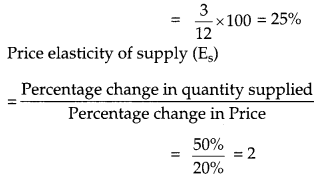
Question 11.
Explain the effect of (a) change in own price and (b) change in price of substitute on demand of a good. [4]
Answer:
Effect on demand of good if :
(a) Change in own Price : Other things remaining constant, as the price of the goods rises, the quantity demanded of the goods falls, on the other hand as the price of the goods falls, the quantity demanded or the goods rises. Thus price of the goods and its quantity demanded shares a negative relationship.
(b) Change in price of Substitute Goods : In case of substitute goods, if the price of one good increases, the consumer will shift his demand to other substitute good i.e., rise in the price of one good results in a rise in the demand for the other goods.
Section – B
Question 20.
What is revenue deficit in government budget ? [1]
Answer:
Revenue deficit refers to the excess of revenue. Expenditure over revenue receipts. Revenue deficit implies that the government is not able to cover its revenue expenditure by its revenue receipt. In other words, the consumption and administrative expenditure of the government is greater than its tax and non-tax receipts.
Algebraically it is depicted as
Revenue Deficit = Revenue Expenditure – Revenue Receipts.
Question 22.
In an economy an increase in investment by ₹ 100 crore led to ‘increase’ in national income by ₹ 1,000 crore. Find marginal propensity to consume. [3]
Answer:
Given,
ΔI = ₹ 100 crore
ΔY = ₹ 1,000 crore
MPC = ?
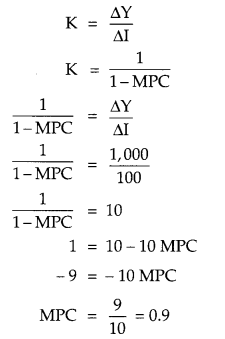
Question 23.
Find gross value added at market price : [3]
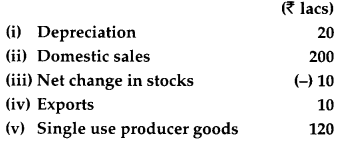
Answer:
Value of output = Sales – Net Change in stock
= (Domestic Sales + Exports) + Net change in Stock
= (200 + 10) + (- 10)
= ₹ 200 lakh
Gross value added at market price = Value of output – Intermediate Consumption
= 200 -120
= ₹ 80 lakh.
Question 25.
Explain how ‘margin requirements’ are helpful in controlling credit creation? [4]
Answer:
The Commercial Banks function to grant loan depends upon the value of security being mortgaged by the borrower so banks keep a margin, which is the difference between the market value of security and loan value. Raising the marginal requirement reduces the maximum amount a borrower can borrow from the Commercial Banks. In this way margin requirements helps in controlling credit creation.
For example, a Commercial Bank grants loan of ₹ 80,000 against the security of ₹ 1,00,000. So margin is calculated as ₹ 1,00,000 – ₹ 80,000 = ₹ 20,000. When the Central Bank decides to control the flow of credit, then margin require-ment of loan is raised.
Question 29.
Find net national product at market price and personal disposable income:
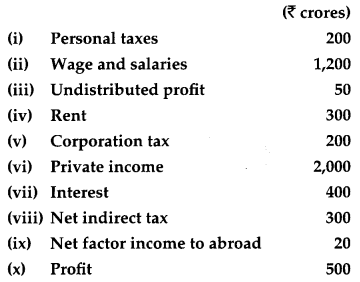
Answer:
NDP
fc
= Wages and salaries + Social security contribution by employers + Rent + Interest + Profit
= 1,200 + 250 + 300 + 400 + 500
= ₹ 2,650 crores.
NNP
mp
= NDP
fc
– Net factor income to abroad + Net indirect tax
= 2,650 – 20 + 300
= ₹ 2,930 crores.
Personal disposable income = Private income – Corporation tax – Undistributed Profit – Personal taxes
– 2,000 – 200 – 50 – 200 = 1,550 crores